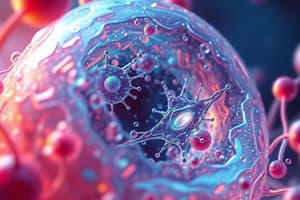Podcast
Questions and Answers
What is the basic structural and functional unit of life?
What is the basic structural and functional unit of life?
Which part of the cell membrane is hydrophobic?
Which part of the cell membrane is hydrophobic?
Which type of cells includes both male sperms and female oocytes?
Which type of cells includes both male sperms and female oocytes?
What is included in the cytoplasm?
What is included in the cytoplasm?
Signup and view all the answers
What is one of the key roles of the cell membrane?
What is one of the key roles of the cell membrane?
Signup and view all the answers
Which of the following organelles is a membranous organelle?
Which of the following organelles is a membranous organelle?
Signup and view all the answers
Which part of the phospholipid is hydrophilic?
Which part of the phospholipid is hydrophilic?
Signup and view all the answers
Which statement is true regarding nonmembranous organelles?
Which statement is true regarding nonmembranous organelles?
Signup and view all the answers
What percentage of the cell membrane is made up of membrane carbohydrates?
What percentage of the cell membrane is made up of membrane carbohydrates?
Signup and view all the answers
What is NOT a component of the cytoskeleton?
What is NOT a component of the cytoskeleton?
Signup and view all the answers
Which type of membrane protein is embedded within the lipid bilayer?
Which type of membrane protein is embedded within the lipid bilayer?
Signup and view all the answers
In terms of ion concentration, which statement is correct?
In terms of ion concentration, which statement is correct?
Signup and view all the answers
What is the primary function of glycocalyx?
What is the primary function of glycocalyx?
Signup and view all the answers
Which organelle is responsible for energy production?
Which organelle is responsible for energy production?
Signup and view all the answers
Which statement describes somatic cells?
Which statement describes somatic cells?
Signup and view all the answers
What function does the glycocalyx primarily serve?
What function does the glycocalyx primarily serve?
Signup and view all the answers
What structure primarily provides fluidity to the cell membrane?
What structure primarily provides fluidity to the cell membrane?
Signup and view all the answers
Which of the following contributes to the structural support of the cell?
Which of the following contributes to the structural support of the cell?
Signup and view all the answers
Study Notes
Cellular Level of Organization
- The basic structural and functional unit of life is a cell.
- Cells are the smallest unit that can perform all life functions.
- Cells can only arise from pre-existing cells.
- Cells maintain homeostasis.
Types of Cells
- Somatic cells: All body cells except sex cells.
- Sex cells: Reproductive cells including male sperms and female oocytes (eggs).
Structure of The Cell
- The cell is composed of:
- Cytoplasm: All materials inside the cell and outside the nucleus.
- Nucleus: Contains the cell's genetic material.
- Cell membrane: Outermost layer that separates the cell from its environment.
Cell Membrane
- The cell membrane is composed of:
- Phospholipid bilayer:
- Hydrophilic heads facing outward.
- Hydrophobic tails facing inward.
- Cholesterol: Contributes to the membrane's fluidity.
- Other lipids: Play a part in membrane function.
- Proteins: Essential for various functions:
- Integral proteins: Embedded within the membrane.
- Peripheral proteins: Located on the inner or outer surface.
- Phospholipid bilayer:
Functions of the Cell Membrane
- Physical isolation: Acts as a barrier.
- Sensitivity to environment: Responsive to extracellular fluid composition and chemical signals.
- Regulates exchange: Controls the movement of ions, nutrients, waste, and cellular products.
- Structural support: Provides structure for cell-to-cell and cell-to-tissue interactions.
Functional Types of Membrane Proteins
- Cell-cell junctions
- Enzymes: Catalyze reactions.
- Transporters: Move substances across the membrane through channels or carriers.
- Recognition: Provide identification for other cells.
- Anchors: Attach to cytoskeleton for structural support.
- Receptors: Bind to ligands, triggering cellular responses.
Membrane Carbohydrates
- Carbohydrates are part of complex molecules like glycolipids, glycoproteins, and proteoglycans.
- The glycocalyx is the layer of carbohydrates that extends outside the cell membrane.
- Glycocalyx functions:
- Anchoring and protection.
- Lubrication and locomotion.
- Specificity in binding (receptors).
- Recognition (immune response).
Cytoplasm
- Cytosol: Intracellular fluid containing dissolved materials like nutrients, ions, proteins, and waste.
- Organelles: Structures with specific functions, further divided into:
- Nonmembranous organelles: No membrane, in direct contact with the cytosol.
- Membranous organelles: Enclosed by a membrane, isolated from cytosol.
Nonmembranous Organelles
- Cytoskeleton: Provides structure, strength, and flexibility to the cytoplasm.
- Composed of: - Microfilaments: Thin filaments responsible for cell movement. - Intermediate filaments: Intermediate in size, provide structural support. - Thick filaments: Found in muscle cells, involved in muscle contraction. - Microtubules: Hollow tubes, support structure and transport.
- Microvilli: Finger-like projections that increase surface area.
- Centrioles: Role in cell division.
- Cilia: Hair-like structures for movement.
- Ribosomes: Sites of protein synthesis.
- Proteasomes: Break down and recycle proteins.
Membranous Organelles
- Endoplasmic reticulum: Network of interconnected membranes.
- Rough ER: Has ribosomes attached, involved in protein synthesis.
- Smooth ER: No ribosomes, involved in lipid synthesis and detoxification.
- Golgi apparatus: Modifies and packages proteins.
- Lysosomes: Contain enzymes for digestion and waste removal.
- Peroxisomes: Contain enzymes for detoxification.
- Mitochondria: Powerhouses of the cell, responsible for ATP production.
Studying That Suits You
Use AI to generate personalized quizzes and flashcards to suit your learning preferences.





